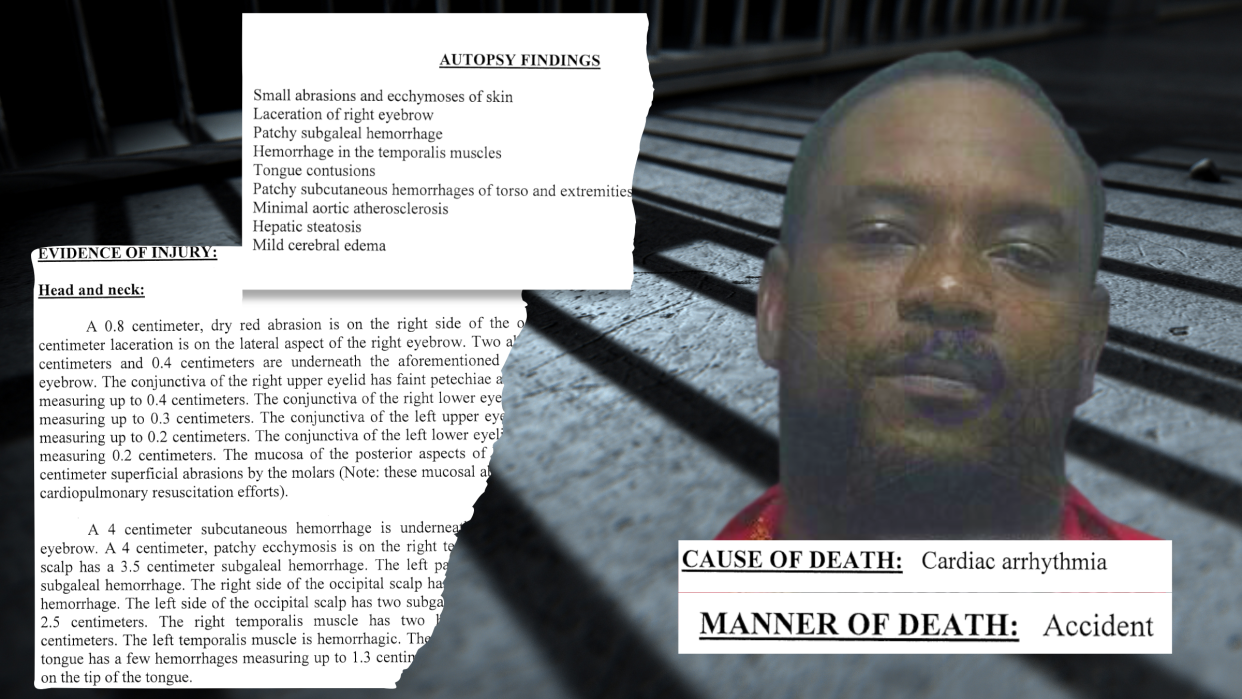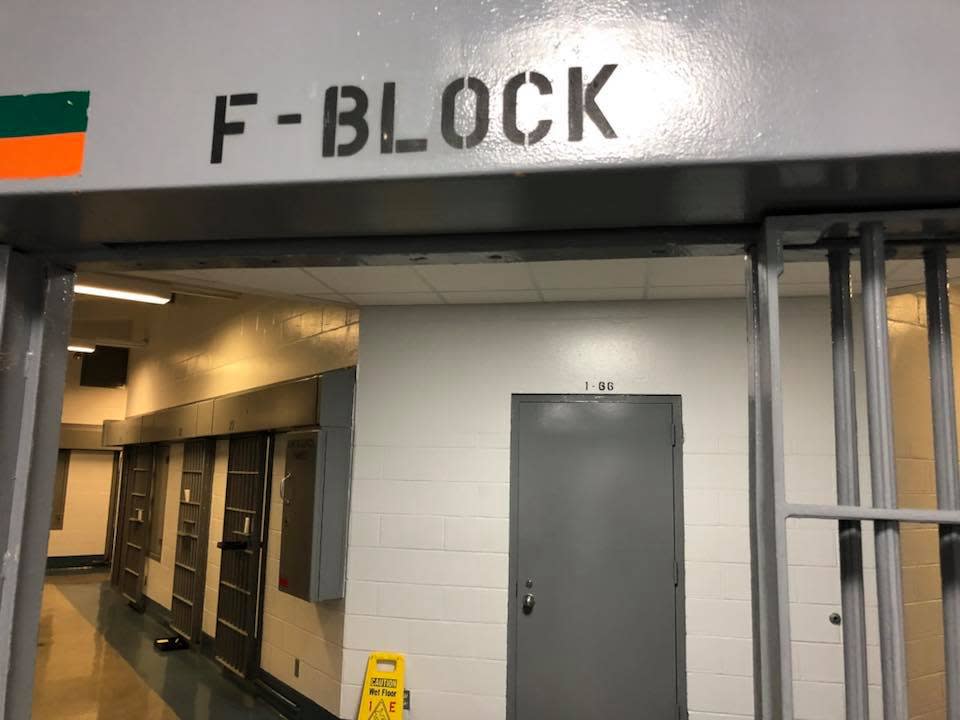Autopsy contradicts Lee County sheriff's account of jail inmate's death

On Sept. 13, 2022, five days after Carl Harper Jr. died in a cell in the Lee County Jail, the president of the local NAACP chapter stood at a podium with Sheriff Carmine Marceno to deliver a message:
Nothing to see here.
“At this time, there is no sign of trauma,” Marceno said.
That assessment was wrong, according to an investigation by The News-Press / Naples Daily News.
Harper’s autopsy report concluded that Harper died accidentally, from a heart arrhythmia caused by drug toxicity. But it also documented multiple injuries to his face, head and neck that experts say are clear signs of blunt force trauma.
And witnesses from within Harper’s cell block say they heard Harper screaming and sounds of a violent struggle with guards in the minutes before he died.
“It sounded like he was being stomped in there,” said Travis Fletcher, an inmate who was housed near Harper’s cell that day.
“From the autopsy there were no signs of any blunt force or trauma," Lee County NAACP President James Muwakkil told The News-Press / Naples Daily News in an interview at the time.
The Lee County Sheriff’s Office conducted a formal investigation after Harper’s death, which was reviewed by the Office of State Attorney Amira Fox. That review stretched on until May, when her office closed the case without filing charges.
The News-Press / Naples Daily News based this investigation on Harper’s autopsy and toxicology reports, interviews with experts who independently reviewed those documents, court filings, conversations with three inmates who were in Harper’s cell block that afternoon and audio recordings from the Lee County Sheriff’s Office’s death investigation.
Two forensic pathologists reviewed Harper’s autopsy for this story. Both said the injuries described in the report showed that Harper had sustained multiple impacts on both sides of his body. They could not determine from the autopsy whether the injuries were caused by deliberate strikes, falls, or accidental collisions.

Those injuries would not have been lethal, they said. But both said it was possible, though not proven, that an altercation with guards could have contributed to Harper’s heart stopping. Both independently noted that the autopsy found burst blood vessels under Harper's eyelids and a hemorrhage on one of his neck muscles – injuries sometimes found on people who die after struggling to breathe.
“That indicated there was kind of intense pressure around the neck and or head,” said Joseph Felo, an Ohio-based forensic pathologist who has conducted more than 4,000 autopsies. “That could be anywhere from pressure around his neck, him being positioned face-down for example, or if he was having a violent seizure."
The autopsy report attributed the death solely to a heart arrhythmia caused by drugs in Harper’s system.
“The question is why did he have the fatal arrhythmia at the time he was restrained in the chair and a spit mask was being placed,” said Howard Robin, a California-based forensic pathologist with four decades of experience testifying as a medical expert witness.
Harper was one of 11 people who died in Lee County jails in 2022, the highest total in at least five years, according to records obtained in a public records request. None of the deaths, which included suicides, drug overdoses and other medical emergencies, were ruled homicides.
In Florida, jails are run by sheriffs, county governments or private contractors and are not regulated by the state Department of Corrections. Facilities are inspected by the Florida Model Jail Standards Commission, which consists of members appointed by the Florida Sheriffs Association and Florida Association of Counties.
The Commission gave Lee County’s jail system a clean bill of health in its 2022 inspection, finding no violations in its facilities or its policies.
The State Attorney’s Office declined to comment, referring The News-Press / Naples Daily News to investigation records it provided through a public records request. The 21st District Medical Examiner's Office did not respond to a request for comment.
The Sheriff’s Office did not respond to a detailed list of findings and questions sent by email last week, saying it does not comment on "pending or active litigation." A search of federal and state court records showed no current lawsuits relating to Harper's death, and the Sheriff's Office did not respond to a request for records of any pending litigation prior to publication.
In an interview last week, Muwakkil said the NAACP was offered a copy of the autopsy before the press conference but did not review it because they toured the jail after Harper’s death and found no signs of foul play.
“Inmates told us that deputies did not do anything wrong,” Muwakkil said.
When told the autopsy actually did show multiple blunt force injuries, he said the NAACP would take another look and change its stance if the facts merited it.
“We have no problem with re-establishing our position,” he said.
A fateful arrest
It was 1 a.m. on Sept. 7, and Carl Harper Jr was allegedly strung out and on the edge.
In a call to the Lee County Sheriff’s Office, Harper’s wife said he had been using molly, a synthetic street drug, and was making violent threats.
Dimethylpentylone: New street drug implicated in Lee County inmate death

“The complainant explained the suspect was walking up and down the hallway yelling that he would kill his canine, everyone in the house and himself,” Deputy Paz Becerra wrote in her report. “She stated she feared for the suspect’s well-being due to his behavior and asked for deputies to go to the residence to check on the suspect.”
When deputies arrived, they found Harper standing over his bed, his arms braced on the mattress and a Smith & Wesson handgun inches from his right hand, Becerra wrote. Deputies took Harper into custody and ran his information, finding he was not allowed to own a gun due to a prior felony conviction. In 2018, Harper pleaded no contest to unarmed robbery for stealing a woman’s cell phone and served 14 months in state prison.
Harper’s wife gave deputies a bag of powder that she said Harper had dropped on the floor. Deputies arrested him on drug possession and firearms charges and booked him into the Lee County Jail that morning, according to a sheriff’s office incident report. His booking photo showed no visible injuries on his face.
Harper’s wife declined to speak to a reporter for this story.
Harper was calm during his booking, according to statements that jail personnel later gave to sheriff’s detectives. But that night, his behavior became erratic.
Deputies placed Harper in a communal cell to wait for his court appearance the next day. Cellmates said he started waking them up in the middle of the night and talking incoherently, according to recordings of interviews with detectives.
Harper was not violent, but his behavior annoyed and concerned cellmates, who called for guards. Corrections officers placed him in an individual holding cell.
The next morning Harper refused to go to court, Corrections Deputy Jose Chimelis told a sheriff’s detective. Hours later, guards were ordered to move Harper from a holding cell to other housing in the jail’s F Block, a loop of cells known to inmates as the “horseshoe.”

Fight with guards
That afternoon, inmate Oscar Davis was talking to a corrections deputy when the officer cut their conversation short, Davis said in a law enforcement interview obtained by this news organization through a public records request.
“He was like oh, hold on a second, we’re going to beat this person’s ass,” Davis told detectives. A second inmate corroborated his account in a separate interview with investigators.
Sheriff’s detectives interviewed the deputies involved and inmates in nearby cells within hours of Harper’s death. The following account is based on recordings of those interviews obtained through a public records request.
Deputies had been ordered to move Harper, so they approached his holding cell and told him to come to the bars. He obliged, and they cuffed his hands behind his back. But when they opened the door, Harper ran to the back of the cell, began yelling and refused to come out, deputies said.
The deputies grabbed him and he tried to kick and squirm out of their grasp. They said they took him to the ground without injuring him and bound his legs and upper body with emergency response belts – flexible restraints designed to wrap up and immobilize struggling inmates.
They brought a wheelchair to Harper’s cell and lifted him into it before rolling him to cell 6 in the jail’s F block. Once inside, they put Harper on the floor and began removing the belts. Then, they said, he grabbed Deputy Brandon Gardner and pulled him down to the ground.
It was a busy cell block, heavily trafficked by newly booked inmates, and inmate Travis Fletcher did not think much of it when he saw corrections deputies wheel Harper into cell 6.
Then the screaming started, he told The News-Press / Naples Daily News in an interview.
“I heard a lot of commotion,” Fletcher said.
Fletcher said he heard sounds of a violent struggle coming from Harper’s cell, though he did not have a direct sightline.
“He was screaming as he was going in,” inmate Thomas Deane, who was housed in a cell adjacent to Harper’s, told detectives. “They wheeled him in and I heard a couple of punches being thrown, physical contact.”
Deputies crowded into the cell, held Harper down, reattached the belts and called for a restraint chair, according to interviews they gave to detectives.
At some point in the struggle, Harper sustained a cut near his right eye, which spilled blood onto the cell floor. All the interviewed deputies told detectives they did not see when it happened – the ones holding his legs said they did not have much of a view, and Gardner, who held Harper’s upper body, said he didn’t know either.
“I have no idea to be completely honest with you,” Gardner told detectives. “He was on the ground, we were on the ground, concrete’s hard. I’m guessing behind all of it, he smashed it, we hit it by accident.”
None of the inmates interviewed by investigators had a direct sightline into the cell, according to their statements.
All the guards told detectives they did not strike Harper and that the inmate did not appear to have any other injuries.
With Harper again wrapped up, Sgt. B. Pezzella authorized the use of a restraint chair and moved him again. A jail nurse told detectives that medical staff were checking out the cut above Harper’s eye and needed better lighting than was available in the cell.
The deputies said Harper continued to wriggle as they hoisted him into the chair, removed the emergency restraint belts and began affixing the chair straps to his legs and torso. They also put a “spit hood” over his face, which Gardner described as a preventative measure taken because Harper was “making noises.” Another deputy said Harper appeared to be spitting blood.
By the time the deputies finished tightening the final strap, Harper was no longer moving. And once they brought Harper into the hall, medical staff realized he was not breathing. Deputies took him out of the chair, began CPR and administered a shock from an automated defibrillator. EMS arrived and continued working on Harper for 35 minutes before declaring him dead at 3:39 p.m.

Inconsistent stories
In some cases, the accounts given by deputies contradicted each other.
Pezzella told detectives that Harper was no longer handcuffed by the time he pulled Gardner to the ground. But both Gardner and Chimelis, another deputy in the cell, said that Harper remained cuffed until the restraint chair arrived.
And while Pezzella said Harper was screaming about wanting to die and kill deputies, none of the other staff reported hearing those specific threats. Gardner said he couldn’t recall Harper saying much of anything coherent, except for one thing:
“He was calling out for somebody at one point, like his dad,” Gardner told detectives.
Fletcher said he wanted to prevent Harper’s death from being covered up, so that day he called Muwakkil, head of the Lee County NAACP, and told him what he had witnessed.
Muwakkil contacted the Sheriff’s Office and asked to visit the jail, who obliged. Muwakkil arrived and walked around the horseshoe, Fletcher said, but did not interview him about what he heard and saw.
“I expected to talk to him, but he just turned around, waved at me and kept on walking,” Fletcher said. “I actually stated my name because we had got off the phone not that long ago.”
When Muwakkil appeared with Marceno at a press conference the next week, he said members of his team had spoken to inmates and found no evidence of foul play in Harper’s death.
“There is no pattern or practice of police misconduct, excessive force or fatal force coming from the sheriff’s department both out in the streets and inside the jail,” Muwakkil said.
And he said the inmates who called him, including Fletcher, had lied, saying other inmates who witnessed the incident saw no wrongdoing by deputies.
In 2022, the sheriff’s office gave $5,000 to the Lee County NAACP, according to a list of agency donations obtained through a public records request. Muwakkil initially denied that the NAACP received financial support from the sheriff’s office, but then said he remembered the donation after The News-Press / Naples Daily News informed him it had records of the gift.
Muwakkil said he and his wife are business owners who personally fund the NAACP branch, and that any donation has no impact on his organization’s positions. The organization has not held a fundraiser in three years, he said.
“I fund it all,” Muwakkil said. “Every check written is from our company,”
The News-Press / Naples Daily News was unable to obtain security video from Harper’s cell block. The State Attorney’s Office said surveillance footage was exempt from disclosure under Florida’s public records law, and the Sheriff’s Office said all its videos are routinely deleted after 30 days.
“They just brushed it under the rug,” Fletcher said. “It’s sickening.”
Autopsy findings
The morning after Harper's death, the District 21 Medical Examiner’s Office began the autopsy.
The autopsy report lists his cause of death as cardiac arrhythmia – an irregular heartbeat – caused by acute N,N-dimethylpentylone toxicity. Dimethylpentylone is a synthetic stimulant commonly sold as the street drug “molly,” according to the Center for Forensic Science Research and Education.
It is a relatively new substance and first entered the drug supply in 2021, said Alex Krotulski, a toxicologist who co-authored an analysis of deaths linked to the substance. And, like other synthetic stimulants, it is capable of causing dangerous heart arrhythmias.
The medical examiner also documented blunt force injuries far more extensive than those disclosed by Muwakkil and Marceno.
Harper had a laceration under his right eyebrow – the cut described by deputies in their interviews with detectives. He also had three small hemorrhages under the left side of his scalp, a larger 2.3 inch hemorrhage under his right scalp and scrapes on his arms and legs. And the medical examiner found bleeding in both his left and right temporalis muscles, which connect the skull to the jaw.
The report found no skull fractures or bleeding in the brain, though did list mild cerebral edema – brain swelling, in layman’s terms.
“He’s got multiple impact injuries on many surfaces of his body,” said Felo, a forensic pathologist who reviewed the autopsy for this story. “None of this is just from him falling down once.”
In contrast, Muwakkil said the autopsy found no signs of trauma, and Marceno did not mention any head injuries aside from a single cut.
"The injuries noted by the medical examiner were minor in nature," Marceno said at the press conference. "There was bruising on the wrists and ankles consistent with handcuffs and shackles that were being applied."
Felo and Robin said the autopsy appeared thorough, but noted that the report did not describe the color of the bruises or the appearance of the blood in the hemorrhages – making it impossible to say exactly when those injuries occurred.
And both noted that Harper had burst blood vessels under both eyelids, which is sometimes seen in victims of asphyxiation or hypoxia – low oxygen levels in the blood.
Harper was 5’8” and 250 pounds, according to the autopsy report. Felo and Robin said that when obese people are restrained face-down, they can have difficulty breathing or even suffocate.
“If he’s laying on his chest and his hands are cuffed behind his back and his feet and tied down, that puts a lot of pressure on the abdomen,” Robin said.
If Harper was still responsive when they hoisted him into the restraint chair, that would rule out total asphyxiation from his time being restrained on the cell floor, Felo said. If he was hypoxic but still conscious, that could have theoretically contributed to him suffering a heart attack – though that would be difficult or impossible to prove.
“Was he unresponsive because of the position of his body?” Felo said. “Hopefully that was determined not to be the case, since they listed this as an accident.”
This article originally appeared on Naples Daily News: Florida sheriff's account of jail inmate's death contradicts autopsy

